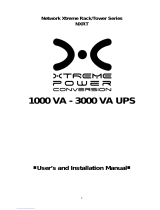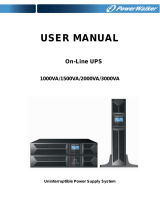
1. Introduction
1.1 Safety instruction
• The UPS must be installed and maintained exclusively by quailified staff. See installation and operation
instructions before connecting to the supply.
• The UPS must be installed with an earth connection. It has a high leakage current. The first wire to be
connected is the earth wire, which must be connected to the terminal marked PE (yellow/green).
• The UPS generates a leakage current of over 3.5 mA. The leakage current of the load should be added to that
of the UPS on the protective earth wire.
• The UPS needs a neutral connection to work properly. Operation without Neutral may damage the unit.
• A readily accessible disconnect device shall be incorporated in the building installation wiring for permanently
connected equipment.
• The UPS generates hazardous electric voltages inside it even when the input and/or battery switches are
open. The inside of the UPS is protected by safety guards that are not to be removed by non-qualified staff. All
installation and maintenance or other operations that entail gaining access to the inside of the UPS require the
use of tools and are to be performed exclusively by qualified staff.
• The UPS contains an energy source: the batteries. All terminals and sockets may be powered even when the
UPS is not connected to the mains.
• The total battery voltage is potentially hazardous: it may cause an electric shock. The compartment containing
the batteries is protected by safety guards, which are not to be removed by non-qualified staff. All battery
installation and maintenance operations entail gaining access to the inside of the UPS and require the use of
tools: these operations are to be performed exclusively by qualified staff.
• The batteries replaced are to be considered as toxic waste and treated accordingly. Dispose of used batteries
according to the instructions. Do not throw the batteries into fire: they could explode. Do not attempt to open
the battery casing: no maintenance work can be done on them. In addition, the electrolyte is hazardous for the
skin and eyes and may be toxic.
• Risk of explosion if battery is replaced by an incorrect type.
• Do not turn on the UPS if you see any leaks of liquid or a white powder residue.
• Make sure that no water, liquid in general and/or other foreign matter gets inside the UPS.
• Under hazardous conditions, turn off the UPS at the “1/0” main power switch and open all the isolators present
(see the user manual to locate the “1/0” main power switch and the isolators).
• Do not open the battery fuse holders while the UPS is powering the load from the batteries. An interruption of
the battery DC voltage may cause an electric arc and result in breakage of the equipment and/or fire.
• The energy required to power the load is provided by the batteries in the event of a power failure. if the battery
protection were open, the load would be powered off.
• Fuses have to be replaced with the same type if necessary.
• To connect external battery cabinets, use the expansion cable suggested by the manufacturer in this manual.























